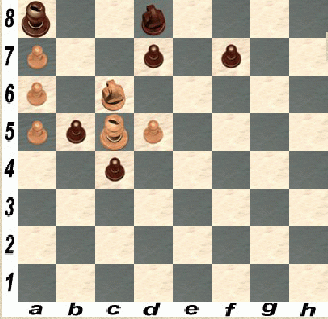An international tournament was held in Mogliano Veneto (near Venice, Italy) April 28th to May 1st. I played a nice game there, it is shown here.
I started playing chess at the age of six, but did not make any progress until 1984, when I played a couple of games with some friends and started thinking that I really liked the game. I then attended a course held by dr. Roberto Pastres, a Chemist and a chess Master, and began to play in Venezia's chess circle "Esteban Canal", where dr. Antonio Rosino, a Math teacher and FIDE chess Master, helped me to gain insight in this wonderful game.
My first tournament was the Italian Chess Championship held by ARCI scacchi in Forli' in December 1984. I played with non classified opponents and scored 3 points in 6 games. After that a long row of tournaments have followed. In one year I become 3rd national category, in another I got to 2nd category, and in 1987 1st category. In 1988 I won the 1st category Mogliano chess tournament and become a Candidate Master.
Since then, I've played a lot of Magistral tournaments, but I never got to the first place (a second place once, though). My ELO rating has kept increasing, and it is currently 2120. Unfortunately Physics is a very time-consuming job, and I have played very rarely since 1993. My best results have been a 3.5/6 in a Magistral Chess Tournament in Mogliano, 1990, and a draw with a russian International Master, Deev (then 2435). My last tournament was Mogliano 1998, where I played 6 games. My results there:
- Dorigo - A.Caruso (M, 2324) 1/2
- K.Klundt (IM,2375) - Dorigo 1-0
- C.Bracaglia (CM,2000) - Dorigo 0-1
- Dorigo - A.Fabris (M,2225) 1/2
- A.Guerra (M,2175) - Dorigo 1-0
- E.Weinberg (CM,1950) - Dorigo 0-1
for a total score of 3/6 and a performance rating of about 2175.
I forgot to mention that I've always liked to compose chess problems. I never submitted any to chess composition tournaments, but some of my achievings are not that bad. You will find some here soon; for the time being let's just have one study: in the following position,

White to move and win.
The solution is quite simple, if you notice that only one is the possible move black has played to reach the given position. In fact, the black Knight cannot have made the last move, since in that case it would have jumped to d8 from either e6 or b7, both of which are squares where the white King would have been under check with black to move: impossible. As for the black King, it cannot have come from b8 to a8, since in b8 it would have been subjected to a double check by Knight in c6 and Pawn in a7, an impossibility in chess. Neither is the move Kb7-a8 possible, since in that case the position would again be illegal: the a6 pawn was then attacking the black King but had not being moved there, being blocked by other pieces the two squares it could have come from (a5 and b5). We therefore come to the conclusion that only a pawn move is possible. But not from the c4 pawn, the three squares b5,c5,d5 being all blocked by other pieces. Therefore only a move from the b5 pawn is possible. Not b6-b5, otherwise black would have had the choice of eating white's king, again illegal. So the last black move was necessarily 0. ..., b7-b5.
So what do we get from that ? Simply that the move 1.a5xb6 !! is possible, and good. An en-passant move in a chess problem is allowed only if it can be proven that the last move to reach the given position was a push of the pawn that is to be taken, as is the case here. By taking 1.a5xb6, white wins very easily, as the reader should see by himself or herself.
On the other hand, very lengthy and not worth the time is the demonstration that there is no possible win for white after any other move. If 1.Nc6xd8, black will queen one of his pawns, and probably win. If 1.Nb4, the c4 and f7 pawns provide black with adequate counterplay against the possible white plan of invading d6 with the king. Other moves are possible but not good enough for a win.
Did you like it ? Send me your comments!
This extraordinary site explains the art of retrograde analysis and contains tons of first-class problems and chess brain-teasers